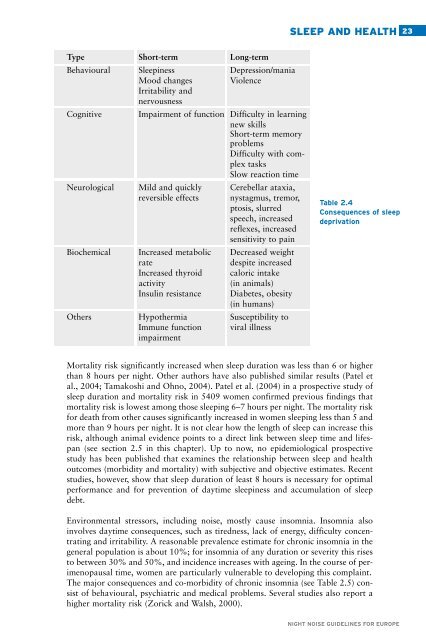Night noise guidelines for Europe - WHO/Europe - World Health ...
Night noise guidelines for Europe - WHO/Europe - World Health ...
Night noise guidelines for Europe - WHO/Europe - World Health ...
Create successful ePaper yourself
Turn your PDF publications into a flip-book with our unique Google optimized e-Paper software.
SLEEP AND HEALTH 23<br />
Type Short-term Long-term<br />
Behavioural Sleepiness Depression/mania<br />
Mood changes Violence<br />
Irritability and<br />
nervousness<br />
Cognitive<br />
Impairment of function Difficulty in learning<br />
new skills<br />
Short-term memory<br />
problems<br />
Difficulty with complex<br />
tasks<br />
Slow reaction time<br />
Neurological Mild and quickly Cerebellar ataxia,<br />
reversible effects nystagmus, tremor,<br />
ptosis, slurred<br />
speech, increased<br />
reflexes, increased<br />
sensitivity to pain<br />
Biochemical Increased metabolic Decreased weight<br />
rate<br />
despite increased<br />
Increased thyroid caloric intake<br />
activity<br />
(in animals)<br />
Insulin resistance Diabetes, obesity<br />
(in humans)<br />
Others Hypothermia Susceptibility to<br />
Immune function viral illness<br />
impairment<br />
Table 2.4<br />
Consequences of sleep<br />
deprivation<br />
Mortality risk significantly increased when sleep duration was less than 6 or higher<br />
than 8 hours per night. Other authors have also published similar results (Patel et<br />
al., 2004; Tamakoshi and Ohno, 2004). Patel et al. (2004) in a prospective study of<br />
sleep duration and mortality risk in 5409 women confirmed previous findings that<br />
mortality risk is lowest among those sleeping 6–7 hours per night. The mortality risk<br />
<strong>for</strong> death from other causes significantly increased in women sleeping less than 5 and<br />
more than 9 hours per night. It is not clear how the length of sleep can increase this<br />
risk, although animal evidence points to a direct link between sleep time and lifespan<br />
(see section 2.5 in this chapter). Up to now, no epidemiological prospective<br />
study has been published that examines the relationship between sleep and health<br />
outcomes (morbidity and mortality) with subjective and objective estimates. Recent<br />
studies, however, show that sleep duration of least 8 hours is necessary <strong>for</strong> optimal<br />
per<strong>for</strong>mance and <strong>for</strong> prevention of daytime sleepiness and accumulation of sleep<br />
debt.<br />
Environmental stressors, including <strong>noise</strong>, mostly cause insomnia. Insomnia also<br />
involves daytime consequences, such as tiredness, lack of energy, difficulty concentrating<br />
and irritability. A reasonable prevalence estimate <strong>for</strong> chronic insomnia in the<br />
general population is about 10%; <strong>for</strong> insomnia of any duration or severity this rises<br />
to between 30% and 50%, and incidence increases with ageing. In the course of perimenopausal<br />
time, women are particularly vulnerable to developing this complaint.<br />
The major consequences and co-morbidity of chronic insomnia (see Table 2.5) consist<br />
of behavioural, psychiatric and medical problems. Several studies also report a<br />
higher mortality risk (Zorick and Walsh, 2000).<br />
NIGHT NOISE GUIDELINES FOR EUROPE

















